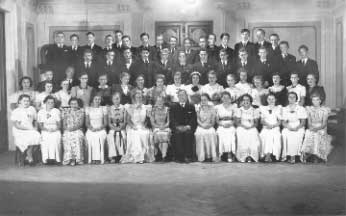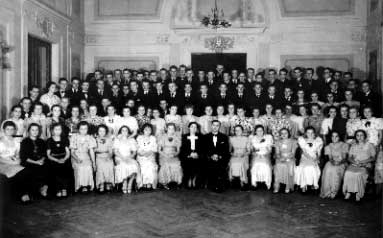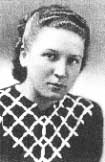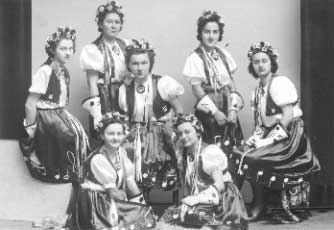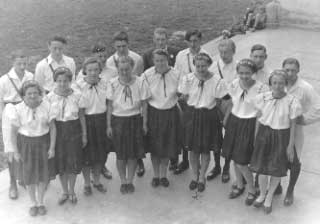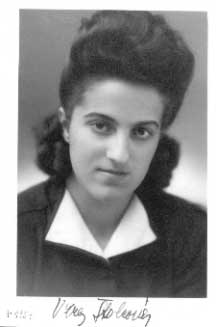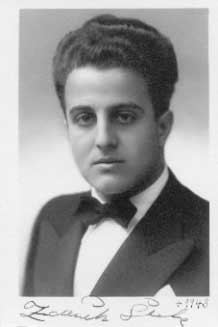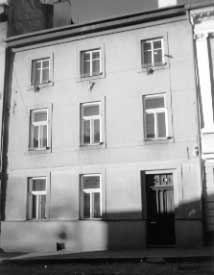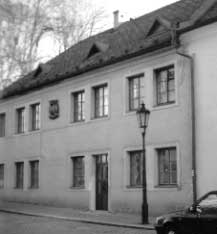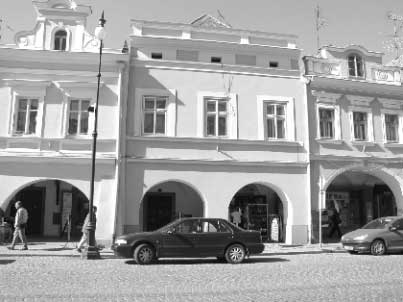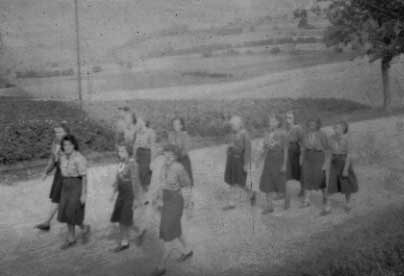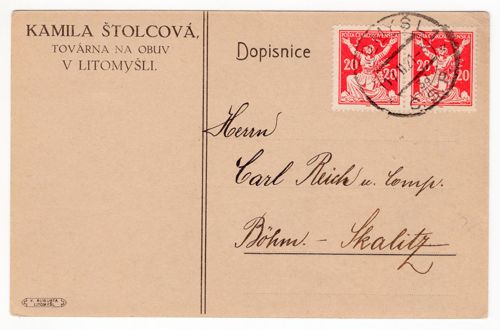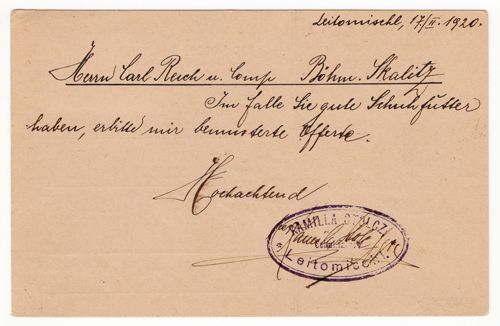The Story of Two Brothers and Their Families
Mr. Oskar Štolc (born on 7th February, 1892) and his wife, Mrs. Anna Štolcová (born on 23rd November, 1896) had two children, Věra and Zdeněk. They lived in a rented house owned by the Verners at what is today 140, Jirásek Street. On the ground floor, there was a ladieswear shop run by Mr. And Mrs. Švercha. The Verner family and the Štolc family lived on the first floor. The Štolc family´s flat was reached by climbing a steep wooden staircase. There was a bell on the front door leading to the flat. The first room behind the door was the kitchen with an airshaft that passed through the whole house from the first floor to the roof like a chimney. The kitchen was small, with a very noisy fridge and a water pipe (this was not normal for all the houses in the square. Most people had a water tap in the corridor outside their front door which was shared by the whole house). Three of the windows of the big living room looked out onto the street towards the post office building. The bedroom was a room in the corner of the building with windows looking out on to the post office and the Olivet Mountain. They had one more little living room. The flat was well furnished with quality furniture, cut glass, and beautiful carpets. They also bought a house in Zahradní Street with a garden.
The Štolc family had a housekeeper, whom they treated like a member of the family, like a granny. They called her Baruška.
Together with his brother Vilém, Mr. Oskar Štolc owned a shoemaking business. Its main office at 14, Jirásek Street could be seen from the Štolcs´ living room. They mainly employed people who worked from home, so they didn´t have any machines.
The family owned a car - a brown Tatra with four seats and a linen sunroof. Mr. Štolc could drive but when he needed to, he hired a driver from Mr. Bydžovský´s firm. He only drove himself on special occasions, like when he took his children and their classmate, Vladimír David, to Prague to see President Masaryk´s funeral. The Štolc family used the car when they went on holiday, normally for about three weeks. They travelled around the country, staying at hotels. We know they were definitely in Bechyně, where Vladimír David visited them, and also in Western Bohemia, probably in the spas. They even went to the Opatia spas in Italy (Opatija in Croatia today). They met the Kadlický family there. Mr. Kadlický was a Latin teacher at the grammar school in Litomyšl and, since the fifth grade, had been the teacher of the Štolcs´ children.
Věra and Zdeněk were twins. They were born on 21st August, 1921. Zdeněk had a round face and black hair. He was quite tall, well built, and also quite lively. Věra was beautiful with black hair. However, she was often wistful. Both of them had big brown eyes and slightly big noses.
They went to the grammar school in Litomyšl. Věra did not enjoy school, but Zdeněk did, especially languages. Among his classmates, he was the best student of German, but he wasn´t very good at maths. His classmates say that it could have been because their maths teacher was Mr. Štemberk, whom they nicknamed Pijón. He was small, mean and did not like tall people - and Zdeněk (as well as nearly everybody else) was tall.
Zdeněk did not drink alcohol, smoke or drive a car. He probably never even learnt how to drive. Věra was very blunt and told everybody what she thought of them, even if it wasn´t nice. Sometimes she was a bit cheeky and Mr. Kudrnáč would tell her off, saying, "Štolcová, don´t be cheeky." Sometimes, she was bigheaded, a little "madam". Zdeněk was good fun though. He didn´t ruin practical jokes. A lot of his classmates used to go to their house. Neither of them was religious.
In their garden in Záhradí, the Štolc family had two tennis tables. Zdeněk, Věra, Vladimír David and Rudolf Mikeš, all of them friends and classmates, would go to play there. Zdeněk was a very good player, the best of all.
Věra and Zdeněk used to go to the dance parties at the Sokol Hall (the gym of the Czech gymnastics organization, Sokol) on Sundays from 5 to 7 p.m. and to the ballroom of the "Hluchanda" pub (in today´s Tyrš Street, where the Litex Company is). Young people went to dance there. Mrs. Pechancová remembers, "When dancing the waltz, Zdeněk used to spin round very fast and this was not my cup of tea. It made me feel dizzy." We know he was an excellent dancer and all the girls wanted to dance with him.
Zdeněk could sing very well. He liked singing the hits played at that time and he had a good sense of rhythm.
Věra Březinová, the daughter of a schoolmaster from nearby Morašice, made friends with Zdeněk. She had possibly been in love with him since fifth grade. Zdeněk liked her as well, but according to Vladimír David, he "was shy". They went out with each other until eighth grade. They saw each other mainly at school, but they also went out dancing. Mrs. Štolcová was not very happy about that, as she considered Věra to be too plain for Zdeněk, even if she was a very good student. After the school-leaving exam, Mrs. Březinová visited the Štolc family and after that visit, Zdeněk and Věra split up.
Mr. Stanislav Kunert, a student of the grammar school in Litomyšl who lived in today´s 426, Komenský Square, told us that one morning, when he was going to school at about half past seven, he saw a black Gestapo car standing in front of Štolcs´ house and two Gestapo men standing next to it. The door to the house was open; the Štolcs were running down the stairs, moved forward by other Gestapo men. Mr. Štolc was running afore. There was no shouting or crying. The Štolcs did not have any luggage. They looked scared but resigned. The next day, posters appeared with their names on, along with those who agreed with the assassination of Heydrich. It could have been a mistake, as, according to transport documents from Terezín, the family was taken to Terezín on Cf transport on 5th December, 1942 from Pardubice. All of them were sent to Auschwitz on 6th September, 1943 in D1 transport. They had the following numbers: Anna - 2157, Oskar - 2158 (both recorded as the Stolzs) and Zdeněk - 2294. We don´t know Věra´s number.
Věra was freed from Neuengamme and returned to Litomyšl. She used to see Zdeněk until almost the end of the war. She believed he would return home and kept waiting for him. She moved to Prague in 1945. She married Dr. Petráň. Mrs. Müllerová used to meet up with Věra in Prague and she remembers that they were really in love. The Petráňs had a son who later trained to be either an electrician or a car mechanic. We know for sure that he was alive in 1950 when Mrs. Müller moved back to Litomyšl. Věra though couldn´t adapt to the post-war world. She suffered from depression. This was probably the reason why she committed suicide in 1954.
Martin Hubinka and Štěpán Kotyza
Oskar Štolc´s younger brother was called Vilém and was born on 25th November, 1894. He was of medium height and well built. He did not smoke. He was a legionary in WWI. His wife Emílie, born on 16th January, 1903, was a small, kind-hearted woman. She liked reading and got on very well with her neighbours. Their son Josef was born on 14th April, 1927. They lived at today´s 44, Smetana Square in a rented house. On the ground floor, there was a barbershop owned by Mr. Josef Pejšman.
The house had a hallway, a large living room with windows leading to the square, a large kitchen with a window leading to the corridor, one room without windows, and a toilet without water supply. The flat was furnished with "the best furniture". They had a Persian carpet and an "American stove" with a stone window. In 1936, water piping was probably installed. Until then, water was brought to the house from the public pump, which was next to the arcade opposite. This is why there is no bathroom in the list of rooms.
Behind the house, in the direction of the river, there was a garden with a pear tree and a lawn, where the Štolc family used to sit and sunbathe. Emilíe would mend socks and clothes there and Vilém would rest on a deck chair with a little shade. Pepík would play with a ball in the garden, trying to hit the gate, which was something that their neighbours, the Sobotkas, did not like, because it made a "terrible noise". They remember how Pepík once hurt himself and his mum chased him round the garden with iodine ointment.
Josef trained to be a shoemaker with Mr. Prášil in Umrlčí Street, in his workshop on the ground floor of the house. The Frieds worked on the first floor. Everybody in the family spoke good German because they used to go on holiday there every year, but otherwise they were rather careful people.
A charwoman used to come to the family home every day to take care of the household. She was treated like a member of the family.
Before transportation began, the Štolcs put their carpet in the care of the Sobotka family. Mr. Štolc said, "Unfold it and walk on it", but the Sobotkas did not have enough room. It was too big, and so they put it in the storeroom, to be joined later by the deck chairs and a huge suitcase (with dresses on hangers inside). The family of a German officer was supposed to move to the flat, but they came to have a look at it and never moved in. They probably didn´t like it. After the war, the Sobotkas returned everything to Mrs. Bubeníčková, Vilém´s sister, who came to pick up her brother´s things.
The Štolc family left Litomyšl on 2nd December, 1942 for Pardubice, and from there to Terezín on 5th December. On 23rd January, 1943 they were sent in Cr transport to Auschwitz. Vilém´s number was 1182, Emílie´s number was 1183 and Josef´s 1184. They died there.
Vojtěch Jána
Note: Oskar and Vilém had a sister Valérie, who got married before the war and whose married name was Bubeníčková. We phoned her daughter Marie Hoffmanová, who lives in Pardubice. She promised to share her memories with us, telling us she would call us once she had time but she never did.
Dagmar Burdová
